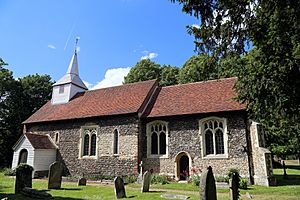St Andrew's Church, Willingale facts for kids
Quick facts for kids St Andrew's Church, Willingale |
|
|---|---|

St Andrew's Church, Willingale, from the south
|
|
| Lua error in Module:Location_map at line 420: attempt to index field 'wikibase' (a nil value). | |
| OS grid reference | TL 596 073 |
| Location | Willingale, Essex |
| Country | England |
| Denomination | Anglican |
| Website | Churches Conservation Trust |
| Architecture | |
| Functional status | Redundant |
| Heritage designation | Grade II* |
| Designated | 20 February 1967 |
| Architectural type | Church |
| Style | Norman, Gothic |
| Specifications | |
| Materials | Flint with some freestone and puddingstone Dressings in clunch and re-used Roman bricks Roofs tiled |
St Andrew's Church is a historic Anglican church in the small village of Willingale, Essex, England. It is no longer used for regular church services, which is why it is called a redundant church. This special building is looked after by the Churches Conservation Trust. St Andrew's is very important because it is a Grade II* listed building, meaning it has special historical interest. What makes it even more unique is that it stands less than 50 metres (about 164 feet) from another church, St Christopher's, and they both share the same churchyard!
Contents
History of St Andrew's Church
This church has a long history, with parts of it being very old. The main part of the church, called the nave (where people sit), was built way back in the 12th century. That's over 800 years ago! The chancel, which is the area near the altar, was added later in the 15th century.
In the 1800s, during the Victorian era, the church was restored. This means it was repaired and updated to make sure it stayed in good condition. During this time, a porch was added at the entrance, and a vestry (a room for the clergy) was also built.
Exploring the Church's Design
Outside the Church
St Andrew's Church is built mostly from flint stones, which are small, hard rocks. You can also see some freestone (stone that can be cut easily) and puddingstone (a type of rock with rounded pebbles). The special stones used for details, like around windows and doors, are made from clunch and even old Roman bricks that were reused! The roofs are covered with tiles.
The church has a simple shape, with the nave and chancel. There's a porch on the south side and a vestry on the north side. At the west end, you'll see a wooden belfry (where the bells are) and a spire on top. Both of these are covered with weatherboarding, which protects the wood from the weather.
The windows are from different time periods. The large east window, which is from the 1800s, has three sections with fancy Decorated-style patterns. On the north side of the chancel, there are two windows from the 15th century. Between them, you can see where an old doorway used to be. The south side has similar windows and a doorway from the 15th century too.
In the north wall of the nave, there are two very old 12th-century windows with rounded tops. There's also a doorway from the same period with amazing 12th-century ironwork that looks like scrolls. On the south wall, you'll find three different windows: a tall, narrow lancet window from the 13th century, a two-part window from the 14th century, and a small 12th-century window. The south porch, also covered in weatherboarding, leads to a 12th-century doorway with a rounded top and stone and Roman brick sides. The west window has a rounded brick top, likely from the 1600s.
Inside the Church
As you step inside, one of the oldest features you'll see is the font, which is where baptisms take place. This octagonal (eight-sided) font is from the late 14th century. It's decorated with quatrefoils (shapes like four-leaf clovers) inside circles, and panels with carved roses and faces.
In the chancel, there are 15th-century piscinae, which are small basins used for washing sacred vessels. You can also see an oolite altar slab (the top of the altar) with carved crosses. The church also has memorials from 1614 that remember the children of the church's rector (the main priest). There used to be an organ made in 1905, but it was removed by 1997. In the tower, there are two bells, and one of them has a special message carved into it from the 15th century.
More to Explore

